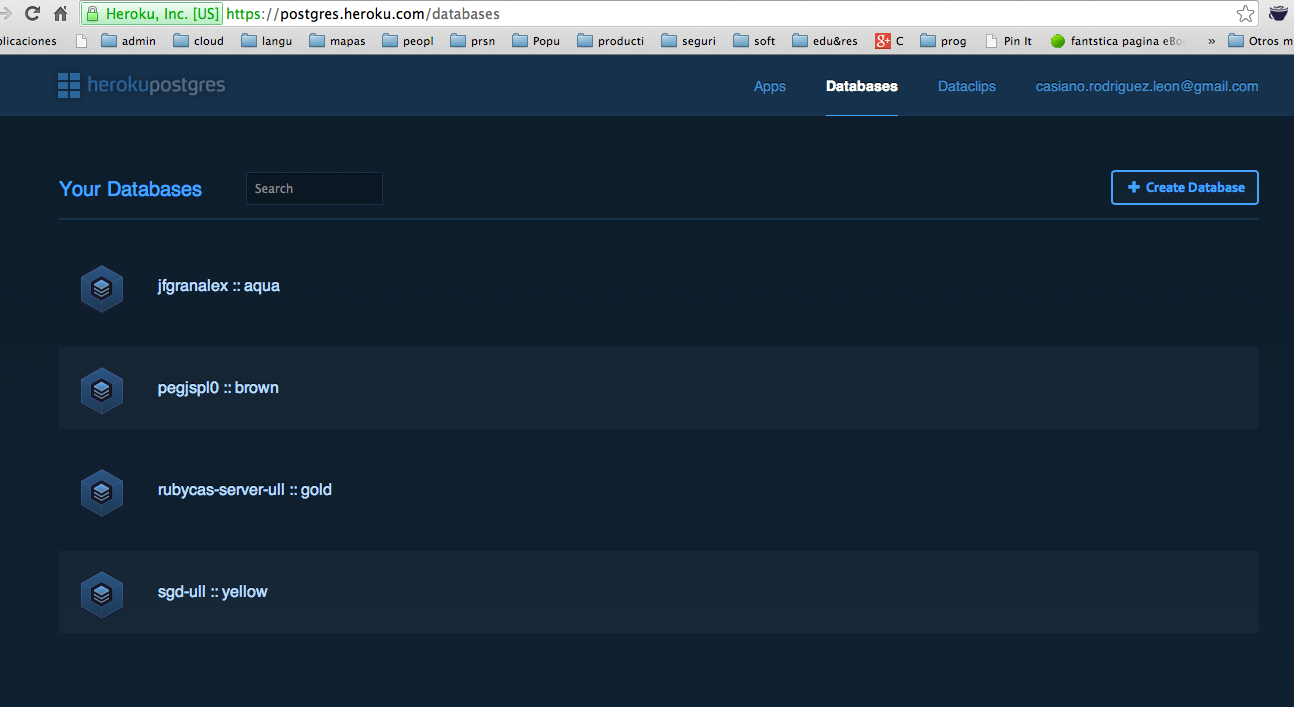

Sig: Troubleshooting Sup: Heroku Ant: Logging Con:
Véase Heroku Postgress.
Heroku Postgres is the SQL database service run by Heroku that is provisioned and managed as an add-on.
Heroku Postgres is accessible from any language with a PostgreSQL driver including all languages and frameworks supported by Heroku: Java, Ruby, Python, Scala, Play, Node.js and Clojure.
[~/srcPLgrado/pegjscalc(master)]$ heroku addons === pegjspl0 Configured Add-ons heroku-postgresql:hobby-dev HEROKU_POSTGRESQL_BROWN
In addition to a variety of management commands available via the Heroku CLI, Heroku Postgres features a web dashboard, the ability to create dataclips and several additional services on top of a fully managed database service.

Your language’s buildpack documentation will specify if any add-ons are automatically provisioned.
Additionally, you can use heroku addons
to
see if your application already has a database provisioned and what plan
it is58.2.
[~/srcPLgrado/pegjscalc(master)]$ heroku addons === pegjspl0 Configured Add-ons heroku-postgresql:hobby-dev HEROKU_POSTGRESQL_BROWN
If your application doesn’t yet have a database provisioned, or you wish to upgrade your existing database or create a master/slave setup, you can create a new database using the CLI.
$ heroku addons:add heroku-postgresql:dev Adding heroku-postgresql:dev to sushi... done, v69 (free) Attached as HEROKU_POSTGRESQL_RED Database has been created and is available
Once Heroku Postgres has been added a HEROKU_POSTGRESQL_COLOR_URL
setting
will be available in the app configuration and will contain the URL
used to access the newly provisioned Heroku Postgres service.
This can
be confirmed using the heroku config command.
[~/srcPLgrado/pegjscalc(master)]$ heroku config === pegjspl0 Config Vars DATABASE_URL: postgres://moiwgreelvvujc:GL3shXGOpURyWOPrS2G8qaxzUe@ec2-23-21-101-129.compute-1.amazonaws.com:5432/dat9smslrg6g0a HEROKU_POSTGRESQL_BROWN_URL: postgres://moiwgreelvvujc:GL3shXGOpURyWOPrS2G8qaxzUe@ec2-23-21-101-129.compute-1.amazonaws.com:5432/dat9smslrg6g0a LANG: en_US.UTF-8 PGBACKUPS_URL: https://453643:cqz59jrxbbfcxj0fanhjfg0vz@pgbackups.herokuapp.com/client RACK_ENV: production
Heroku recommends using the DATABASE_URL config var to store
the location
of your primary database.
[~/srcPLgrado/pegjscalc(master)]$ head main.rb
require 'sinatra'
require "sinatra/reloader" if development?
require 'sinatra/flash'
require 'data_mapper'
require 'pp'
# full path!
DataMapper.setup(:default,
ENV['DATABASE_URL'] || "sqlite3://#{Dir.pwd}/database.db" )
In single-database setups your new database
will have already been assigned a HEROKU_POSTGRESQL_COLOR_URL
config with
the accompanying DATABASE_URL.
You may verify this via heroku config and
verifying the value of both HEROKU_POSTGRESQL_COLOR_URL
and DATABASE_URL
which should match.
To see all PostgreSQL databases provisioned by your application and the
identifying characteristics of each
(db size, status, number of tables, PG version, creation date etc…)
use the heroku pg:info command.
[~/srcPLgrado/pegjscalc(master)]$ heroku pg:info === HEROKU_POSTGRESQL_BROWN_URL (DATABASE_URL) Plan: Hobby-dev Status: available Connections: 0 PG Version: 9.3.3 Created: 2014-03-20 23:33 UTC Data Size: 6.5 MB Tables: 1 Rows: 4/10000 (In compliance) Fork/Follow: Unsupported Rollback: Unsupported
To continuously monitor the status of your database, pass pg:info through the unix watch command:
[~/srcPLgrado/pegjscalc(master)]$ watch heroku pg:info -bash: watch: no se encontró la orden [~/srcPLgrado/pegjscalc(master)]$ brew install watch [~/srcPLgrado/pegjscalc(master)]$ watch heroku pg:info ...
psql is the native PostgreSQL interactive terminal and is used to execute queries and issue commands to the connected database.
To establish a psql session
with your remote database use heroku pg:psql.
You must have PostgreSQL installed on your system to use heroku pg:psql.
[~/srcPLgrado/pegjscalc(master)]$ heroku pg:psql
---> Connecting to HEROKU_POSTGRESQL_BROWN_URL (DATABASE_URL)
psql (9.2.6, server 9.3.3)
WARNING: psql version 9.2, server version 9.3.
Some psql features might not work.
SSL connection (cipher: DHE-RSA-AES256-SHA, bits: 256)
Type "help" for help.
pegjspl0::BROWN=> \dt
List of relations
Schema | Name | Type | Owner
--------+--------------+-------+----------------
public | pl0_programs | table | moiwgreelvvujc
(1 row)
pegjspl0::BROWN=>
pegjspl0::BROWN=> SELECT * FROM pl0_programs;
name | source
--------+-----------------------------
3m2m1 | 3-2-1\r+
|
ap1tb | a+1*b\r +
|
test | a+1*b\r+
| \r +
|
lolwut | 3-2-1\r+
|
(4 rows)
If you have more than one database, specify the database to connect to as
the first argument to the command (the database located at DATABASE_URL
is used by default).
$ heroku pg:psql HEROKU_POSTGRESQL_GRAY Connecting to HEROKU_POSTGRESQL_GRAY... done ...
pg:reset:
[~/srcPLgrado/pegjscalc(master)]$ heroku pg:reset DATABASE ! WARNING: Destructive Action ! This command will affect the app: pegjspl0 ! To proceed, type "pegjspl0" or re-run this command with --confirm pegjspl0 > pegjspl0 Resetting HEROKU_POSTGRESQL_BROWN_URL (DATABASE_URL)... doneEs necesario a continuación rearrancar el servidor:
[~/srcPLgrado/pegjscalc(master)]$ heroku ps:restart Restarting dynos... done
pg:pull can be used to pull remote data from a Heroku Postgres
database to a database on your local machine. The command looks like this:
[~/srcPLgrado/pegjscalc(master)]$ pg_ctl -D /usr/local/var/postgres -l /usr/local/var/postgres/server.log start server starting
$ heroku pg:pull HEROKU_POSTGRESQL_MAGENTA mylocaldb --app sushiThis command will create a new local database named
mylocaldb and
then pull data from database at DATABASE_URL from the app
sushi.
In order to prevent accidental data overwrites and loss, the local database must not exist. You will be prompted to drop an already existing local database before proceeding.
pg:push will push data from a local
database into a remote Heroku Postgres database. The command looks
like this:
$ heroku pg:push mylocaldb HEROKU_POSTGRESQL_MAGENTA --app sushiThis command will take the local database
mylocaldb
and push it
to the database at DATABASE_URL on the app sushi.
In order to
prevent accidental data overwrites and loss, the remote database must
be empty. You will be prompted to pg:reset an already a remote database
that is not empty.
Casiano Rodríguez León